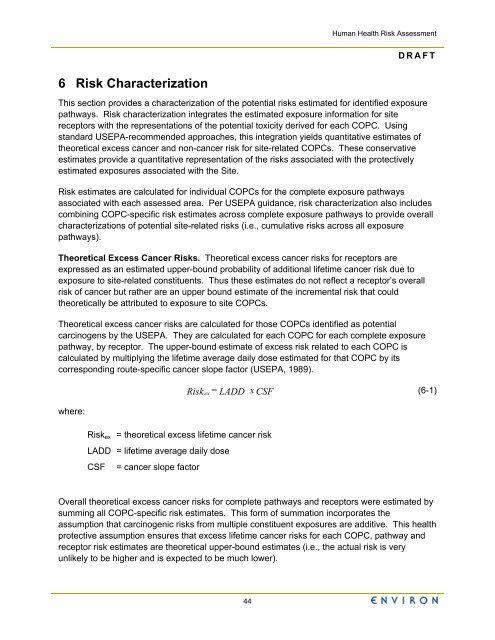Human Health Risk Assessment - Raytheon
Human Health Risk Assessment - Raytheon
Human Health Risk Assessment - Raytheon
You also want an ePaper? Increase the reach of your titles
YUMPU automatically turns print PDFs into web optimized ePapers that Google loves.
6 <strong>Risk</strong> Characterization<br />
44<br />
<strong>Human</strong> <strong>Health</strong> <strong>Risk</strong> <strong>Assessment</strong><br />
DRAFT<br />
This section provides a characterization of the potential risks estimated for identified exposure<br />
pathways. <strong>Risk</strong> characterization integrates the estimated exposure information for site<br />
receptors with the representations of the potential toxicity derived for each COPC. Using<br />
standard USEPA-recommended approaches, this integration yields quantitative estimates of<br />
theoretical excess cancer and non-cancer risk for site-related COPCs. These conservative<br />
estimates provide a quantitative representation of the risks associated with the protectively<br />
estimated exposures associated with the Site.<br />
<strong>Risk</strong> estimates are calculated for individual COPCs for the complete exposure pathways<br />
associated with each assessed area. Per USEPA guidance, risk characterization also includes<br />
combining COPC-specific risk estimates across complete exposure pathways to provide overall<br />
characterizations of potential site-related risks (i.e., cumulative risks across all exposure<br />
pathways).<br />
Theoretical Excess Cancer <strong>Risk</strong>s. Theoretical excess cancer risks for receptors are<br />
expressed as an estimated upper-bound probability of additional lifetime cancer risk due to<br />
exposure to site-related constituents. Thus these estimates do not reflect a receptor’s overall<br />
risk of cancer but rather are an upper bound estimate of the incremental risk that could<br />
theoretically be attributed to exposure to site COPCs.<br />
Theoretical excess cancer risks are calculated for those COPCs identified as potential<br />
carcinogens by the USEPA. They are calculated for each COPC for each complete exposure<br />
pathway, by receptor. The upper-bound estimate of excess risk related to each COPC is<br />
calculated by multiplying the lifetime average daily dose estimated for that COPC by its<br />
corresponding route-specific cancer slope factor (USEPA, 1989).<br />
where:<br />
<strong>Risk</strong>ex = theoretical excess lifetime cancer risk<br />
LADD = lifetime average daily dose<br />
CSF = cancer slope factor<br />
<strong>Risk</strong> ex = LADD x CSF<br />
(6-1)<br />
Overall theoretical excess cancer risks for complete pathways and receptors were estimated by<br />
summing all COPC-specific risk estimates. This form of summation incorporates the<br />
assumption that carcinogenic risks from multiple constituent exposures are additive. This health<br />
protective assumption ensures that excess lifetime cancer risks for each COPC, pathway and<br />
receptor risk estimates are theoretical upper-bound estimates (i.e., the actual risk is very<br />
unlikely to be higher and is expected to be much lower).

















